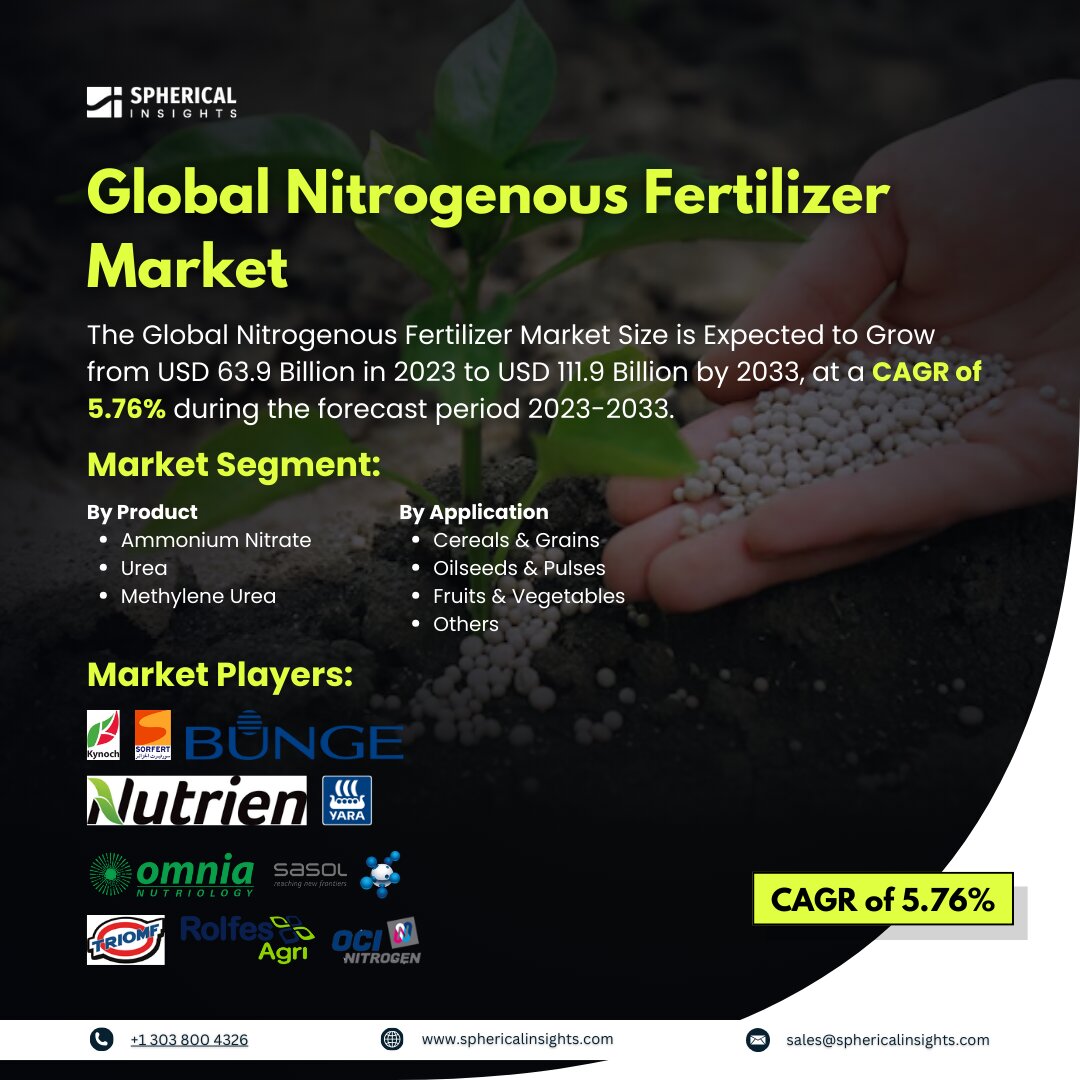Global Nitrogenous Fertilizer Market Size to worth USD 111.9 Billion by 2033
According to a research report published by Spherical Insights & Consulting, the Global Nitrogenous Fertilizer Market Size is Expected to Grow from USD 63.9 Billion in 2023 to USD 111.9 Billion by 2033, at a CAGR of 5.76% during the forecast period 2023-2033.
Browse key industry insights spread across 210 pages with 110 Market data tables and figures & charts from the report on the Global Nitrogenous Fertilizer Market Size, Share, and COVID-19 Impact Analysis, By Product (Ammonium Nitrate, Urea, and Methylene Urea), By Application (Cereals & Grains, Oilseeds & Pulses, Fruits & Vegetables, and Others), and By Region (North America, Europe, Asia-Pacific, Latin America, Middle East, and Africa), Analysis and Forecast 2023 – 2033.
Nitrogenous fertilizers are chemical compounds that contain nitrogen, which is an important nutrient for plant growth. They are mainly used to improve agricultural productivity by increasing soil fertility and improving crop yield. The common types include urea, ammonium nitrate, ammonium sulfate, and calcium ammonium nitrate, which are extensively applied across cereals, oilseeds, fruits, and vegetables. The increasing demand for food globally, driven by a growing population and shrinking arable land, has been the main driver of the market for nitrogenous fertilizers. Improvements in agricultural practices and the increased adoption of precision farming techniques have also increased the demand for these fertilizers. In addition, government initiatives and subsidies to encourage the use of fertilizers to increase crop output have contributed significantly to market growth. The expansion of bio-based fertilizers also provides growth opportunities as it addresses the environmental concerns associated with conventional fertilizers. However, the market is facing several challenges, such as stringent environmental regulations regarding nitrogen emissions and the overuse of fertilizers, which leads to soil degradation and water contamination.
The urea segment is predicted to hold the greatest market share through the forecast period.
Based on the product, the nitrogenous fertilizer market is classified into ammonium nitrate, urea, and methylene urea. Among these, the urea segment is predicted to hold the greatest market share through the forecast period. Urea’s dominance is attributed to its high nitrogen content, cost-effectiveness, and widespread use across various crops. Additionally, its ease of storage, transport, and application enhances its preference among farmers globally.
The cereals & grains segment is anticipated to hold the greatest market share during the projected timeframe.
Based on the application, the nitrogenous fertilizer market is divided into cereals & grains, oilseeds & pulses, fruits & vegetables, and others. Among these, the cereals & grains segment is anticipated to hold the greatest market share during the projected timeframe. This is because cereals and grains, such as wheat, rice, and maize, are staple crops with high global demand for both human consumption and animal feed. These crops require significant amounts of nitrogen-based fertilizers to enhance yield and productivity, especially in regions with intensive farming practices.
Asia-Pacific is estimated to hold the largest nitrogenous fertilizer market share over the forecast period.
Asia-Pacific is estimated to hold the largest nitrogenous fertilizer market share over the forecast period. The growth is mainly due to more available land to cultivate, beneficial climatic conditions, and a greater rural population. The top multinational producers of nitrogenous fertilizers are setting up their manufacturing plants in countries of Asia as demand has been rising there and people there are now also giving much emphasis to food security. China is the largest user of the product worldwide and uses approximately one-third of the total global consumption of the product.
Europe is predicted to have the fastest CAGR growth in the nitrogenous fertilizer market over the forecast period. Growth has been attributed to the sizeable landmass in the region which is occupied by grasslands and agriculture. Imports of nitrate-based fertilizers are from Russia, Egypt, and Algeria; phosphate-based products are primarily from Morocco, while compounds of NPK have been mainly sourced from Norway and Russia.
Competitive Analysis
Major key players in the nitrogenous fertilizer market are Kynoch Fertilizer, Sorfert, Bunge Ltd., Nutrien Ltd., Yara, Omnia Holdings Limited, Sasol, Aquasol Nutri, TriomfSA, Rolfes Agri (Pty) Ltd., OCI Nitrogen, ICL Fertilizers, Eurochem Group AG, CF Industries Holdings Inc., Koch Fertilizer, and Others.
Key Target Audience
- Market Players
- Investors
- End-users
- Government Authorities
- Consulting And Research Firm
- Venture capitalists
- Value-Added Resellers (VARs)
Market Segment
This study forecasts global, regional, and country revenue from 2023 to 2033. Spherical Insights has segmented the nitrogenous fertilizer market based on the below-mentioned segments:
Global Nitrogenous Fertilizer Market, By Product
- Ammonium Nitrate
- Urea
- Methylene Urea
Global Nitrogenous Fertilizer Market, By Application
- Cereals & Grains
- Oilseeds & Pulses
- Fruits & Vegetables
- Others
Global Nitrogenous Fertilizer Market, By Regional Analysis
- North America
- Europe
- Germany
- UK
- France
- Italy
- Spain
- Russia
- Rest of Europe
- Asia Pacific
- China
- Japan
- India
- South Korea
- Australia
- Rest of Asia Pacific
- South America
- Brazil
- Argentina
- Rest of South America
- Middle East & Africa
- UAE
- Saudi Arabia
- Qatar
- South Africa
- Rest of the Middle East & Africa



